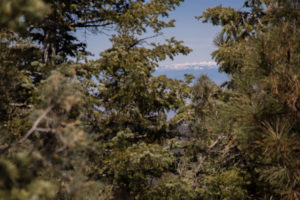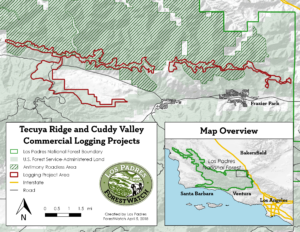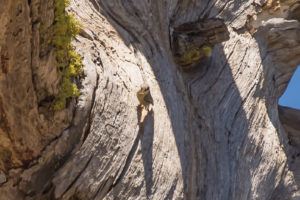In March, Los Padres National Forest officials announced plans to fast-track two massive commercial logging projects near Mt. Pinos. These projects would involve removing trees of all sizes and up to 95% of sagebrush habitat along 12 miles of Tecuya Ridge and across 1,200 acres of Cuddy Valley between Lockwood Valley and the San Emigdio Mountains. In the announcement, the Forest Service indicated that both projects would be excluded from environmental review.
The logging and clearing would affect nearly 4.5 square miles of some of the only truly forested land in the Los Padres as well as over 1,000 acres of the Antimony Inventoried Roadless Area. This area is home to several species of conifers such as ponderosa, Jeffrey, and pinyon pines as well as white fir and bigcone Douglas-fir. Because of this unique makeup of coniferous forest, the area supports dozens of species of threatened, endangered, sensitive, and rare wildlife including the California condor, California spotted owl, Tehachapi white-eared pocket mouse, monarch butterfly, and San Emigdio blue butterfly. The Audubon Society considers Tecuya Ridge to be an Important Bird Area due to its important habitat for condors and spotted owls. Despite these well-known occurrences of rare and sensitive species, the Forest Service is attempting to exempt the projects from its normal procedures to fully evaluate the impacts of logging and clearing activities on wildlife and other natural special features of the area. Additionally, because they plan to exempt the project from environmental review, the public is only being given one 30-day opportunity to submit comments on the projects.
The Forest Service has refused ForestWatch’s repeated requests for additional information about the projects, including project boundary data, timber stand surveys, and a listing of which rare plants and animals may be affected. Forest officials have also failed to respond to our request for access to the project sites. This lack of transparency makes it difficult for the public to submit meaningful comments on the proposal.

Tecuya Ridge is one of the few places where the snow-capped Sierras can be seen from the Los Padres National Forest.
Threats to Wildlife
To fill this information gap, we’ve been working with our own biologists and other experts to determine the potential impacts these massive logging projects would have on species such as the iconic and endangered California condor. With less than 300 condors in the wild, preserving their habitat on public lands like the Los Padres National Forest is critically important. Our analysis of four years of condor data revealed 14 roosting sites within the Tecuya Ridge project area and an additional 24 roosting sites within a half-mile of the project area. Roosts — ancient trees that condors use for rest and shelter during long flights across the landscape — are vitally important to the long-term survival of the species. The Forest Service’s own standards prohibit intrusive activities within a half-mile of condor roosts. Over 65% of the Tecuya Ridge project area is within this half-mile roost buffer zone, yet the Forest Service does not plan to fully analyze how the project will impact these critical sites.
California spotted owls — a species currently under endangered status review by the U.S. Fish and Wildlife Service — have also been known to occur around the Tecuya Ridge project area. These owls need dense, old-growth coniferous forests with multi-layered canopies to thrive. Recently, several scientific studies have shown that spotted owls also need standing dead trees — known as snags — for foraging and nesting habitat. The recent multi-year drought in our region caused significant tree die-off in and around these project areas. These dead trees became hosts to native bark beetles, which in turn provide abundant food for other important bird species such as woodpeckers and nuthatches. The latest science is clear: logging these areas — targeting snags and mature trees — can be detrimental to owls and other species.
Unsupported by Science
But what about the effects of overgrown forests and dead trees on wildfire? Interestingly, studies have shown that dead trees do not increase the risk of wildfire. In fact, they may actually reduce the intensity of fire — even when tree mortality is due to beetles. In addition to reducing the number of large fire-resistant trees, thinning can decrease shaded canopy cover, which can then increase understory temperatures. This reduces moisture and opens up forested areas to more wind — both factors that can cause wildfires to spread faster and hotter. A recent study even showed that the most protected mixed-conifer forests and those with generally the greatest amount of vegetation may actually burn at lower severity levels than forests unprotected from logging. We support protecting communities from wildfires, which is why we advocate for approaches that are supported by science and shown to be effective. These include creating defensible space and focusing vegetation removal directly next to homes, retrofitting and building structures with fire-safe materials, and reducing development in the wildland-urban interface.
Changing Course on Transparency
The Forest Service’s announcement reverses the agency’s previous commitment to prepare more detailed Environmental Assessments (EAs) for logging and clearing projects. In response to ForestWatch’s concerns about six projects proposed in 2005, the agency announced that it would prepare EAs — the simplest form of environmental review required by the National Environmental Policy Act — for these similar and even smaller logging projects around Mt. Pinos, Frazier Park, and Figueroa Mountain. These assessments not only examine the potential impacts of proposed projects, but increase transparency and the public’s ability to weigh in.
Send Your Letter Today!
The proposed projects on Tecuya Ridge and in Cuddy Valley must be held to the same standards as past logging projects in the Los Padres. There is a public comment period open until April 19, and this may be the only chance the public has to weigh in with concerns about these projects. Click here to easily submit a comment to the Forest Service letting them know they should, at minimum, prepare an Environmental Assessment that would thoroughly analyze the potential impacts to rare and sensitive species before conducting any work. They should also consider alternatives to commercial logging, as this approach has been shown to degrade bird habitat and increase wildfire severity.
We will continue to update our website with more information about these projects as it becomes available.











Comments are closed.